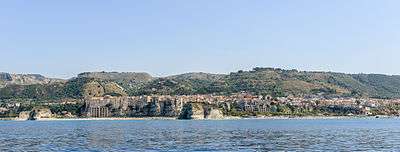Tropea
Tropea (Italian: [troˈpɛːa]; Calabrian: Trupìa; Latin: Tropaea; Ancient Greek: Τράπεια, romanized: Trápeia) is a municipality in the province of Vibo Valentia, in Calabria, southern Italy.
Tropea | |
|---|---|
| Comune di Tropea | |
View of the historic centre of Tropea | |
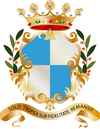 Coat of arms | |
Location of Tropea 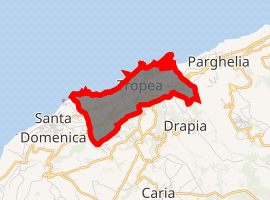
| |
 Tropea Location of Tropea in Italy 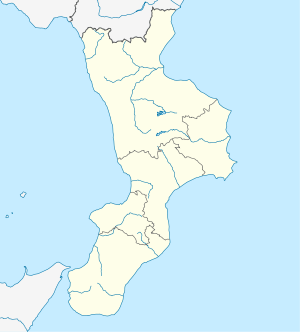 Tropea Tropea (Calabria) | |
| Coordinates: 38°40′45″N 15°53′55″E | |
| Country | Italy |
| Region | Calabria |
| Province | Vibo Valentia (VV) |
| Frazioni | Marina |
| Government | |
| • Mayor | Giovanni Macrì (Forza Italia) |
| Area | |
| • Total | 3.2 km2 (1.2 sq mi) |
| Elevation | 60 m (200 ft) |
| Population (30 November 2015)[2] | |
| • Total | 6,462 |
| • Density | 2,000/km2 (5,200/sq mi) |
| Demonym(s) | Tropeani (dialectal: Trupiani) |
| Time zone | UTC+1 (CET) |
| • Summer (DST) | UTC+2 (CEST) |
| Postal code | 89861 |
| Dialing code | 0963 |
| Patron saint | St. Madonna of Romania |
| Saint day | March 27 |
| Website | Official website |
Tropea is a seaside resort with sandy beaches, located on the Gulf of Saint Euphemia, part of the Tyrrhenian Sea, on Italy's west coast.
History
A legend suggests that the town was founded by Hercules when returning from his labours at the Pillars of Hercules (the modern-day Strait of Gibraltar). Graves of Magna Graecian origin have been found near Tropea.
Along Tropea's coast, Sextus Pompey defeated Octavius. The Romans built a commercial port in Formicoli, approximately 3 km south of Tropea.
Main sites
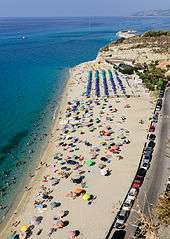
- Franciscan monastery
- Monastery of Santa Maria dell'Isola
- 12th century Norman cathedral
- Tropea Castle, which was destroyed in 1876
The Virgin Mary of Romania
A painting of the Virgin Mary from around 1330 hangs in the Cattedrale di Maria Santissima di Romania, a church constructed in Tropea in the 12th Century. The painting is known as the Virgin Mary of Romania and is of Byzantine origin.
An unconfirmed story asserts that it was carried aboard a ship sailing from the Eastern Roman Empire, when the boat was driven into the port of Tropea by a storm. After repairing the damage, the captain tried to depart, but the ship could not leave the harbour. The bishop of the city, Ambrogio Cordova, dreamed repeatedly that the Virgin Mary was asking him to keep her in Tropea and to protect her. The bishop gathered officials and citizens and went to the ship, where they took the picture. As soon as the painting was brought to shore the ship allegedly left the town.
The Virgin Mary is said to have appeared to the bishop several times in his dreams, warning him of an earthquake that would devastate Calabria. On 27 March 1638 a bishop organised a penitential procession for the people from Tropea, which meant they were out of harm's way when the earthquake struck.
Other events have been attributed to the Virgin Mary's protection, including Tropea being spared from the worst of the 1783 Calabrian earthquakes and when six bombs fell on the town in Tropea in the Second World War, but failed to explode.
People
- Pasquale Galluppi - philosopher.
- Raf Vallone - actor.
- Albert Anastasia - an American mobster.
Tropea onions
Villages around Tropea produce red onions that are well-known in Italy. Cipolle di Tropea ("Tropea onions") have become a synonym in Italy for all red onions.
External links
| Wikimedia Commons has media related to Tropea. |
- Pro Loco Tropea - tourist office
- Museo Antichi Mestieri
- Brief History of Tropea
- Photos of Tropea and surrounding areas
- Photo Gallery (in Italian)
- "Superficie di Comuni Province e Regioni italiane al 9 ottobre 2011". Istat. Retrieved 16 March 2019.
- "Popolazione Residente al 1° Gennaio 2018". Istat. Retrieved 16 March 2019.
